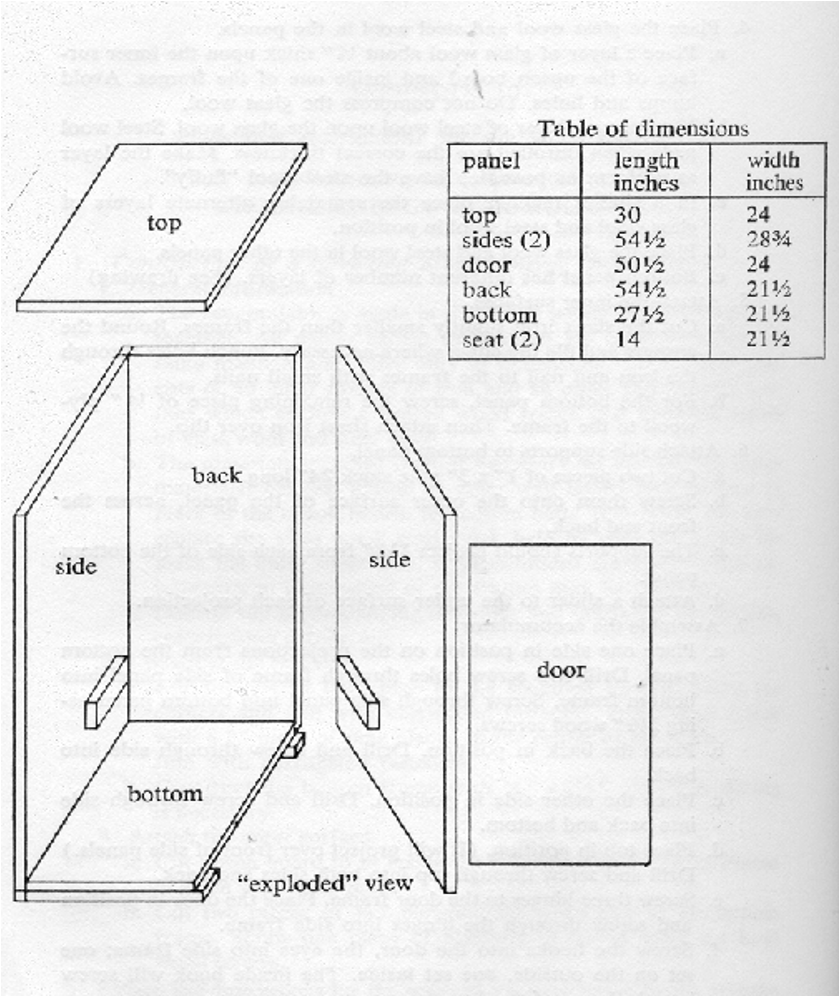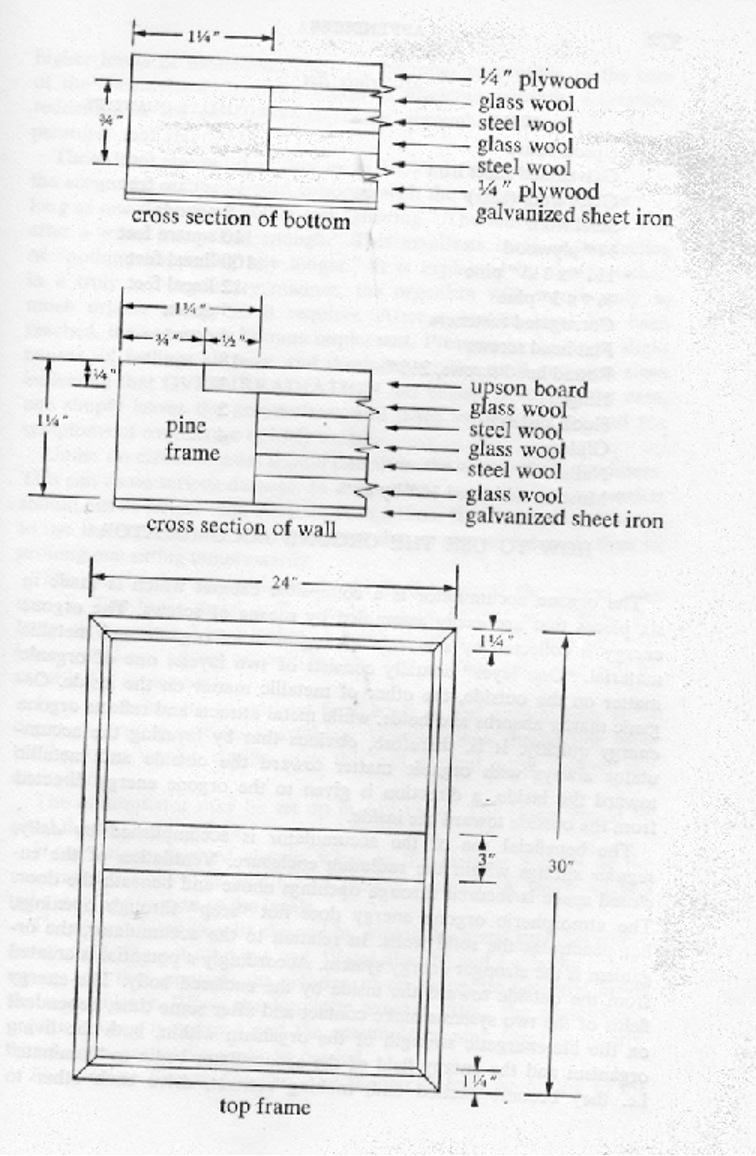RADIESTHESIA TIDINGS

Orgone Accumulator
THE ORGONE ACCUMULATOR (ORAC)
Reich never claimed that the orgone accumulator "cured" anything. Indeed, based on my experimentation with accumulators in the last fifteen years or so, I would not claim any such thing either, but not for the same reasons. Cause and effect are neat, tidy constructs which suit our anthropocentric mindset, however, Nature does not operate in the way man thinks only.
From Reich’s experiment and the observations of others and myself, it seems clear that the accumulator modifies the frequency affecting what is placed inside.
Quite what the nature of this “frequency modification” is would require extensive research which has never been performed to my knowledge. At the time Reich got into trouble with the US authorities in the 1950s, atomic weapons were being developed and there was no question of some obscure scientist producing a palliative, which is what in essence he did, and consequently any possible interest in research was nipped in the bud.
What is more, something as simple as the interaction of combined organic and inorganic materials (metal and wood) being able to influence matter is not considered as a serious proposition by modern science. But what can one say when the results are there to demonstrate that good things happen after a short stay – twenty minutes – in the box!
Not only for people and animals, but food and water.
In the current worldwide situation of elevated and ever-rising levels of radiation, with absolutely no effort at sustainable protection, what can be lost by trying the only thing that has proved its efficacity in the past.
If there was such a thing as an individual dosimeter which could be applied on a person, then placed in a clean environment – free of any atmospheric radiation, to be then applied again on that same person after a twenty-minute stay in an orgone accumulator so as to have a fresh reading without any external influence, I would try to obtain one. But a Geiger counter has to be calibrated which is impossible in current environmental radiation levels. The world is inundated by alpha radiation (beta too in places, and of course gamma in Japan, Ukraine and numerous other hot spots) so it would be impossible, outside of a clean room, to do that without picking up background radiation, so falsifying readings in the whole operation.
What is more prevalent is the radiation coming from frequencies used in telecommunications. It is proportionally more dangerous because so common and using an extensive range of the frequency band. Numerous cases of death and injury caused by what is loosely termed “microwave” radiation have been recorded but not publicized, since the late 1930s, when radar was being developed. The damage continues and the impact on the environment is blithely ignored.
The current view of radiological pathology, and EMF-caused problems fall into that category, is that radiation acts upon living tissue and blood, causing nausea, bleeding, headache, etc. In the same way, it was, and is still believed, that a bacterial infection causes inflammation and high temperature.
That is not quite the case if you take the broader view of the world where humans are part of the whole, rather than the center. Any organism reacts against an invader and a bacteria can be contemplated as just a trigger causing the organism to try and defend itself.
So, the orgone accumulator can be used to relieve the human metabolism of some of the harmful effects generated by the long-lived, deep-penetrating but short-range electromagnetic frequencies (EMFs) that have such devastating impact on Nature and all her creatures. This would include frequencies of all origins, not just nuclear.
There are some conditions to consider if using the orgone accumulator to reduce the effects of EMF radiation. There is a need to sit in it every two-to-three weeks to keep radiation levels down, because those effects accumulate. It would not be a good idea to build one in many areas of Japan at the risk of triggering a violent reaction similar, if not worse, to what Reich experienced at Organon in Maine during his Oranur experiment in 1950-51.
You can find all the necessary information, even films to build an accumulator on the net but I include my two-cents worth below.
The external, atmospheric orgone energy is attracted to, and penetrates the inside of the orgone accumulator and of course makes contact with the energy field of the person inside. Reich named this interaction of the two fields, lumination.
It is, of course, the cosmic forces which govern the whole of life on our planet by means of the vast spectrum of frequencies to which everything owes its existence, maintenance and destruction. Man has severely compromised some of those frequencies, but we have absolutely no idea to what extent, because science does not generally investigate effects downstream unless there is a financial need to do so.
The fact remains that whatever we call “energy” is in and around us all and it is modified by every event, however small or insignificant, but to what extent or depth shall always remain an unknown until such time that it hits you in the face or you are diagnosed with some form of imbalance. If we unconsciously control our existence by breathing, digestion and circulation how much better a job we could provide if we were to assume control of the few factors that we can control, such as reducing irradiation! You know the benefits you can achieve by breathing or relaxing muscular tension because of the impact on the emotions and thought, so why not apply the accumulator?
Using the Orgone Accumulator (ORAC)
There is an interaction of at least three energy fields when you use an orgone accumulator, the user in the middle, the accumulator and the environment make contact, so to speak, then followed by a reaction which depends on more factors than we can possibly understand, but the result is generally beneficial. There seems to be an effect on the parasympathetic nervous system, inasmuch as time spent in the ORAC is quality relaxation time; reactions range from pain-relief, easing of tension, enhanced sense of well-being, improved blood-flow to tissues and organs, faster and more easy recovery from physical injury, better digestion and peristalsis (you often hear intestinal gurgling!), improved appetite, loss of the sense of time. For what it is worth I have seen herpes clear after three sessions in a five-fold ORAC, and Morgellons after two sessions – I would have loved to get that news to Joni Mitchell!
Who Can Use the ORAC?
Rather than blindly following Reich’s recommendations – written in the 1940s and 50s, it is strongly suggested that you test for yourself what is best. Things change!
Orgone energy accumulators can be used by almost everyone. However, Reich noted that people with certain blocked or high energy conditions should either be very cautious or not use it. An initial increase in heart beat often occurs when using an orgone accumulating device. Even though this increased rate usually subsides, often to a lower rate than before, nevertheless, it might cause stress to already damaged hearts. So caution is encouraged but asking with a pendulum or kinesiological means should provide an answer.
Conditions that can worsen with orgone accumulator use are skin inflammations, rashes, and conjunctivitis, however, they often improve after regular use. That has been my experience when working with conditions like herpes, morgellons and psoriasis and they even clear completely.
How often and for how long a person should use an orgone accumulator is a question that concerns both the energetic strength of the user and the capacity of the accumulator. There is no mechanical rule as to how long or when to use an orgone accumulator so one more thing to ask the pendulum and like that you can avoid any possibility of staying in there too long. It is best to sit in the box to enable maximum relaxation. I use an egg-timer set to 20 minutes for timing purposes.
Do not introduce or expose electric or electronic devices to the box. Keep the box clean but do not let it get wet.
If you do feel enervated when exiting the box or if you are using it on a regular basis and find difficulty sleeping, reduce the amount of time spent or the frequency of visit. A walk in the open air or a bath is enough to bring you back to a normal state.
The accumulator for sale in Chiang Mai is a three layer device, built to the scale of the ark of the covenant (never be too sure these days!) and measures about 2 metres x 1.40 m x 1.40 m.
Construction of an ORGONE ACCUMULATOR
Thanks and all honour to WILHELM REICH
1. GENERAL
Dimensions of the box (orgone accumulator) will depend on space available. They do not have any vital impact on its effect. The box consists of six sides all made in the same manner with overall size depending on your convenience. The larger it is the heavier it risks being, so consider this beforehand and where the six frames can be stored if you want to dismantle it between use.
Materials to be used depend on what you can find, but it is essential that you use two different materials for the layers/panels. Non-metal - metal – non-metal – metal – non-metal – metal (for a 3-fold box use 3 layers of each material, for a 10-fold box you need 10 layers of each material, etc.). The inner layer must be a metal surface (iron or steel sheet), you can use other metal materials (iron sheet, steel wool, iron/bronze mesh, etc.) to lighten overall weight, without impacting the effect. The outer panel must be non-metal, wood for example as will the sandwiched layers (sheet made of wood, felt, cotton, rock wool, etc.), again cotton or silk is the lightest.
2. CONSTRUCTION
Having decided on the dimensions, cut the components to the specific measurements. These are the instructions from the Wilhelm Reich Foundation:
Frames:
a. Cut the 1 ¼” x 1 ¼” pine to the specified lengths. Mitre the corners and join with corrugated fasteners. Brace each frame with a 3” piece of pine placed in the centre of the frame. Join with the corrugated fasteners.
b. Construct the bottom frame with ¾” x 1 ¼” pine. No bracing is necessary.
c. Attach the outer surface:
d. Cut the plywood to fit inside the rabbets of each frame. Fasten in place with small nails.
e. Cut two pieces of ¼” plywood the same size as the bottom frame. Screw one piece pf plywood to the frame using flat-head wood screws.
Place the steel mesh (or other material) and cotton (or other) in the panels:
a. Place a layer of cotton on the inner surface of the plywood, inside one of the frames.
b. Next, place a layer of steel mesh on the cotton (if using steel wool, do not compress).
c. In the same way, place the remaining alternate layers of cotton and steel.
d. Complete all six panels
Attach the inner surface:
a. Cut the iron sheet slightly smaller than the frames. Round the corners and file the edges
where necessary. Drill holes through the iron and nail to the frames.
b. To consolidate the bottom panel, you can add an extra ¼” plywood to the frame and attach
the iron sheet over this.
Attach the side supports to bottom panel
a. Cut two pieces of 1” x 3” pine wood 24” long.
b. Screw them onto the outer surface of the panel, across the front and back.
c. The supports should project 1 ¼” from each side of the bottom panel.
Assemble the accumulator
a. Place one side in position on the projection from the bottom panel. Drill two screw holes through the frame of the side panel into the bottom frame. Screw 2 ½” wood screws through the side panel into the bottom panel.
b. Place the back panel in position. Drill and screw through the side panel into the back.
c. Place the other side in position. Drill and screw it into the back and bottom.
d. Place the top in position. It will project over the front of the side panels. Drill and screw through the top into both sides and the back.
e. Cut a piece of wood for the seat (21 ½” x 14”).
f. Screw three hinges to the door frame. Place the door in position and screw through the hinges into the side frame
g. Screw the hook onto the door and the eye to the side frame, do this on either side of the door if you want to close it from inside and out.
Optional - Coat the outer surface with shellac.
Materials list
Item Approx. quantity
Plywood (1/4”) 65 square feet
Galvanized iron sheet 60 square feet
Cotton (100% pure) sheet 14 square feet
Steel mesh 14 square feet
1 ¼” x 1 ¼” pine* 100 linear feet
¾” x 3” pine 12 linear feet
Corrugated fasteners 5 dozen
Flat-head screws 4 dozen
Round-head wood screws 2 ½” 18
Hinges 3
Hook and eye 2
· Must be rabbetted ¼” by ½”




